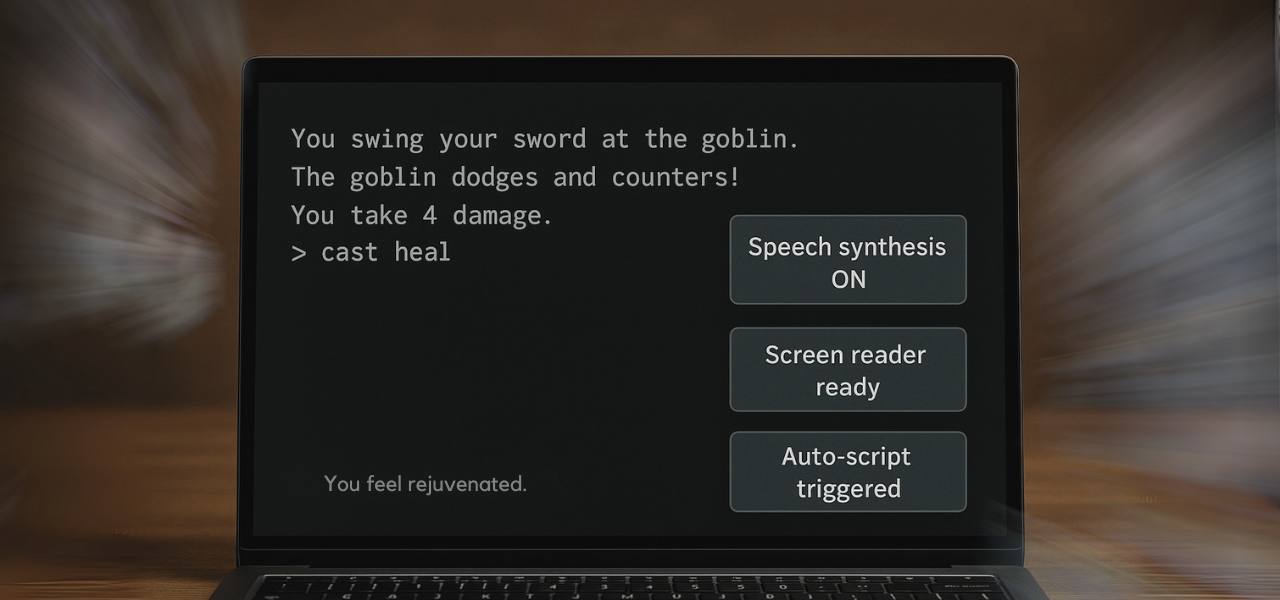Accessibility as a Matter of Survival: MUD Games in 2025
In 2025, an era of hyper-realistic graphics and virtual reality, the world of text-based Multi-User Dungeon (MUD) games may seem like a relic of the past. But against all odds, MUDs have not disappeared. They haven’t just survived — they’ve continued to evolve, attracting players with their unique depth and boundless freedom, where imagination matters more than any visuals.
MUDs represent a distinct form of virtual worlds. There are no high-polygon models or elaborate visual effects. All interaction happens through text, offering unparalleled freedom and immersion.
Compared to modern massively multiplayer online games (MMOs), it becomes clear that text-based worlds prioritize storytelling, roleplay, and social interaction. Players are not mere observers here — they are co-authors of the experience, capable of shaping the world and crafting their own stories.
Core Principles of the MUD Genre

The MUD (Multi-User Dungeon) genre predates modern online games by decades. These were entirely text-based games where players interacted with the world and each other via text terminals and typed commands. Without exaggeration, MUDs can be called the ancestors of MMORPGs — lacking flashy graphics but offering rich textual descriptions and deep roleplay. More details can be found in a separate article: MUD: Multiplayer text games that never get old.
Revival or Quiet Decline?
In 2025, the MUD player community can be described as niche but active. A glance at the Steam game library is enough to grasp how many games have emerged since the early days of MUDs. Of course, most players have migrated to graphical worlds. Yet some remain — those who value atmosphere, roleplay, and live text-based interaction. It’s a small but loyal audience. On platforms like Reddit, MUD communities actively share experiences, discuss old projects, and seek out new ones.
Quantifying Games and Communities
Obtaining precise numbers on active MUD games and players is difficult, as not all projects provide public statistics. Nonetheless, some data is available:
- The site MUDStats.com listed 760 active MUD games as of June 2025. These games receive regular updates, and the site tracks player numbers.
- According to expert estimates, the global number of active MUD players is around 10,000, spread across hundreds of games.
- Community size varies greatly. Some games might have only 10–20 players online, while others consistently attract 70–100 or more. This suggests that certain MUDs foster more engaged communities.
- The subreddit r/MUD has 20,000 members, indicating continued interest in the genre.
What You Need to Play MUDs
All you really need is a computer or smartphone, an internet connection, and a MUD client (a special program for playing). Learning the commands is fairly easy. What truly matters is a desire to immerse yourself in a text-based world and interact with it. For more on getting started, see: MUD World: How to Play for Blind Players.
How the MUD Genre Has Changed in 2025

In 2025, MUD games aim to evolve by preserving their rich narratives and community-centered design while embracing modern game design concepts like immersion, versatility, and high-quality UX design.
To remain relevant, MUDs must skillfully integrate current standards and technologies without sacrificing their textual identity or genre roots. Rather than directly competing with graphical games, MUDs focus on other strengths: accessibility, user experience, dynamic content, character development, and deep, strategic combat. These aspects help attract new players who value narrative depth and retain long-time fans who prefer the text format.
Evolution of Mechanics and New Possibilities
It might seem that text-based worlds should have faded away, giving way to VR and graphical MMOs. Yet today, MUDs are undergoing a quiet revolution. Let’s explore the new mechanics and approaches that keep MUDs alive and relevant — and why now might be the perfect time to create your own world or dive into an existing one.
Procedural Generation: Expanding Worlds and Content
Procedural generation, or procedural content generation (PCG), refers to creating game data using algorithms during runtime. In MUDs, PCG is used to automatically generate locations, rooms, quests, events, NPCs, and monsters. Dungeons can be procedurally built and populated based on templates, remaining in memory until all players leave — then being deleted — which ensures a unique experience every time.
Some MUDs, such as Batmud, use procedurally generated mazes in high-level zones. PCG is also used for item generation, where a “seed” (such as a location hash) ensures item consistency in the generated space. Procedurally generated treasure maps — scaled to the player’s level and monster experience — lead to random rooms packed with loot, encouraging exploration. Procedural Realms, a browser-based MUD, even offers a “vast procedurally generated world” with crafting, survival elements, turn-based combat, and a flexible skill system.
Observations show that while PCG easily creates large numbers of rooms, mazes, and items, it often struggles with quality — producing repetitive room descriptions and disappointingly uniform labyrinths. Without robust algorithms and a clear “rule set,” the results can be underwhelming. This reveals a fundamental issue: while PCG provides scale, the text-heavy nature of MUDs depends heavily on immersive descriptions and compelling storytelling. Simply generating more content without ensuring its narrative and descriptive quality harms the experience, turning a potential strength into a weakness.
AI Integration: Dynamic NPCs and World Events
Traditionally, NPCs in MUDs exhibited simple, fixed behavior — moving along preset paths or functioning like “vending machines.” A more advanced example is the Mayor of Midgaard, who locked the gates at night. While such routines were hardcoded, they could still be disrupted by obstacles.
Now the goal is generative AI capable of creating lore, dialogues, managing NPCs, and even entire game worlds — turning MUDs into truly adaptive and endlessly diverse virtual environments. Modern AI techniques for NPCs include rule-based systems, pathfinding algorithms, behavior trees, machine learning, sensory awareness, and large language models (LLMs) for realistic dialogue and emotional simulation. For example, SlothMUD implemented “mob talk code,” enabling NPCs to respond to player questions in plain English using grammar generators and a history database for context-aware replies.
Although LLM-powered AI offers enormous potential for dialogue and world generation, its real-time use in gameplay may hit a critical barrier: latency. MUDs, despite being text-based, often operate in real time, where quick player input and immediate NPC responses are essential for compelling combat and interaction. Slow AI responses can disrupt the game’s pace and immersion. So the key question becomes whether advanced AI truly enhances player enjoyment — or simply creates a “world simulation” that players may not prioritize.
Class Freedom: Flexible Character Development
Many modern MUDs have moved away from rigid class-based systems toward more flexible, skill-based, or classless progression. In skill-based systems, characters improve by actually practicing skills rather than spending general experience points or being confined to a predefined class.
Examples include:
- Project Bob (RIP), where players earned skill and perk points that could be spent on personalized skill trees.
- Geas, which emphasizes a classless and level-less system. Character growth is based on actual skill use, with hundreds of skills available — making it impossible to fully master every branch.
- Elysium RPG which is also classless and level-less, with progression achieved through learning and accumulating “lessons.” Players can study core skills (physical, magical, crafting) and general abilities, defining their own path.
- Harshlands, described as a skill-based sandbox MUD where players choose roles like crafter, cleric, mystic, or soldier, focusing more on roleplay than combat.
These systems often allow players to reset and reassign skill points without penalties, encouraging experimentation.
By letting players improve skills through “learning by doing,” MUDs promote organic character development that directly reflects the player’s choices and actions — not a predetermined path. This deepens roleplay, as a character’s identity becomes a direct result of gameplay, consistent with the genre’s strong roleplaying tradition.
Although classless systems offer immense freedom, preventing abuse and avoiding a “settled meta-build” is crucial. If players can easily max out skills or exploit system loopholes (e.g., by repeatedly using an easy skill), it undermines progression, exploration, and strategic depth.
This means that successful classless MUDs in 2025 employ balancing mechanisms like diminishing returns for repeated simple tasks, penalties for over-specialization, and dynamic difficulty scaling based on player skill use.
JRPG-Style Combat: Strategic Depth and Tactics
While many MUDs historically used hack-and-slash combat systems, modern MUDs are adopting turn-based or “semi-real-time” combat inspired by JRPGs to introduce greater strategic depth. For example, Procedural Realms drew inspiration from turn-based JRPGs and uses a turn-based combat system.
Key JRPG-inspired combat elements adapted for MUDs include:
- Systems like Active Time Battle (ATB) or action points determine when characters can act and how many actions they can take per turn.
- Limiting ability usage through cooldowns or charges, forcing players to think strategically about when and how to use them.
- Modern JRPGs aim to reduce “mindless grinding,” prioritizing strategic gameplay instead.
- Combat systems can include complex command sequences, ability combos, and weapon synergies, resulting in thousands of tactical options.
- Managing multiple party members in MUDs may take the form of controlling pets or familiars, adding complexity and strategic layering.
- Concepts like Pressure/Stagger systems or Style and Hype meters introduce dynamic elements that push players to adapt their tactics.
Adapting the visual and real-time elements of JRPG combat — like ATB gauges — to a purely text-based environment is a significant design challenge. Successful implementations require solid underlying systems to manage turn order and actions, paired with detailed yet concise textual feedback that conveys complex tactical information without overwhelming the player.
By integrating JRPG-style combat elements, MUDs attract players seeking deeper strategic engagement and an alternative to “mindless grinding.” This shift differentiates them from simpler hack-and-slash MUDs and appeals to an RPG audience that values tactical depth over fast reflexes.
Audio and Interface: Advancements in Accessibility
Enhanced support for screen readers and text-to-speech synthesis is making MUDs more inclusive for visually impaired players. Their text-based nature makes them an ideal fit for such technologies. Screen readers are available on various platforms, and MUDs are actively adapting their output to be compatible with them.
Examples of accessible clients include:
- VIPMud: specifically designed for blind users, compatible with JAWS and NVDA, featuring speech synthesis support and a clean, distraction-free interface.
- Mudlet: supports the commands mudlet access on and mudlet access reader, offers hotkeys, automatic input line clearing, and hiding of sent text to enhance screen reader usability.
- LociTerm: a web client built from scratch with accessibility in mind, optimized for use on modern devices, including mobile.
- Fado: an Android client with text scaling, autocomplete, a high-contrast color scheme, and built-in vibration, speech, and notification commands.
Game-side (server-side) optimizations include:
- Commands to manually enable accessibility mode, as seen in StickMUD, avoiding reliance on automatic detection.
- Commands like rows, brief, and verbose help reduce text volume and filter out unnecessary information. For example, a brief look simplifies room descriptions, offering details only upon request.
- Options to disable ASCII art, split tables into readable lines, and use lists instead of tree structures, making information more screen reader-friendly.
- Sound cues — an effective way to inform players about ongoing actions, especially during dynamic events.
Soundpacks
Soundpacks for MUDs are collections of audio files (background music, ambient sounds, combat effects, event cues, character sounds) that enhance the gameplay experience.
They serve two core functions:
- Improved immersion: Soundpacks allow players to “visualize and feel” the game world more dynamically and engagingly. The sound of rustling leaves, clashing swords, or magical explosions adds a layer of realism to the text-based environment.
- Accessibility: For screen reader users, soundpacks offer “additional cues and information beyond text.” They can signal events like combat, chat messages, or notifications — helping visually impaired players navigate and respond more effectively.
Technically, soundpack integration is based on the MUD Sound Protocol (MSP) and the MUD Client Media Protocol (MCMP). These are key protocols that let the MUD server instruct the client to play specific sounds based on in-game events or actions. MSP is older and audio-focused, while MCMP is newer and more versatile, supporting various media types.
Examples: Long-running MUDs like Alter Aeon, Prometheus, Cosmic Rage, and Procedural Realms offer soundpacks, while Erion MUD regularly updates its audio content.
Hotkeys and Automation
Hotkey systems are critically important in MUDs, boosting player speed, efficiency, and overall satisfaction. They allow users to execute complex commands quickly without typing them out in full.
Functionality includes:
- Bindings and macros: Clients allow assigning commands to specific keys, enabling players to trigger entire sequences of actions with a single keystroke.
- Aliases, triggers, and scripts: These client-side features further automate gameplay. Aliases provide shorthand for long commands, triggers automatically execute commands in response to in-game events (e.g., “You are hungry.” triggers “eat”), and scripts perform multiple actions in sequence.
This increases efficiency by reducing the need for constant typing and allowing faster responses during combat or complex interactions. As a result, productivity rises, particularly during repetitive tasks or intricate gameplay loops.
When assigning hotkeys, it’s crucial to avoid overriding system settings and to account for the quirks of different platforms.
Automatic MUD Client Updates: A Key Step Forward
Automatic client updates have become a logical step in MUD evolution. Users no longer need to manually download new versions — the client stays up-to-date on its own, saving time.
This approach is now implemented in modern desktop clients like Mudlet, as well as in web-based solutions such as LociTerm. It not only accelerates update delivery but also ensures that players get a stable, secure, and fully functional environment.
Benefits of auto-updating include:
- Instant access to new features and bug fixes without user intervention.
- Compatibility with modern standards (GMCP, MSDP, TLS).
- Seamless operation across devices and platforms.
- Reduced developer workload: the client handles interface updates, compatibility, and version management.
Conclusion
Accessibility is no longer an optional feature — it is the foundation of modern MUD design. Integration with screen readers and text-to-speech isn’t just about improving the experience for blind players; it opens the genre to an entire audience otherwise excluded from most visual games. The text-based nature of MUDs makes such adaptations feel natural rather than forced. As a result, accessibility becomes not a compromise, but a competitive advantage — and the basis for a vibrant, diverse community.
Soundpacks serve as an essential bridge between the purely textual nature of MUDs and a richer, multisensory experience. They are not just aesthetic enhancements but fundamental tools that use audio to compensate for the lack of visual cues, deepening immersion for all players and offering vital navigational and situational awareness.
In 2025, the text-based core of MUDs and command-driven gameplay naturally lends itself to hotkey systems and scripting. These tools streamline interaction, increase engagement, and give players the ability to tailor control schemes to their personal preferences.
Overall, MUDs continue to exist and evolve, albeit within their unique niche. This is evidenced by active communities and ongoing updates to many MUD projects. But to meet the expectations of 2025 players, a client must be easy to use, accessible everywhere, and capable of updating itself — without prompts or complications.
